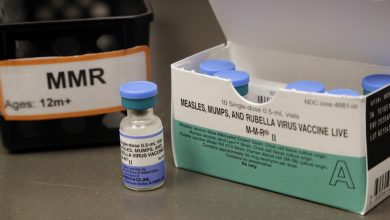Genetic Basis for Facial Changes in Down Syndrome Identified
دراسة تحدد الأساس الجيني لتغيرات الوجه في متلازمة داون
Technology Network
London: Researchers at the Francis Crick Institute, King’s College London and University College London have shed light on the genetics behind changes in the structure and shape of the face and head in a mouse model of Down Syndrome.
Described in a paper published today in Development, the researchers found that having a third copy of the gene Dyrk1a and at least three other genes were responsible for these changes taking place in development – called craniofacial dysmorphology – which involve shortened back-to-front length and widened diameter of the head.
Affecting 1 in 800 live births, Down Syndrome is known as a ‘gene dosage disorder’ – meaning that it involves changes in the number of copies of a gene. People with Down Syndrome have three copies of chromosome 21 instead of two. Having three copies of certain genes on this chromosome causes aspects typical of Down Syndrome, but it’s not yet known which genes are responsible.
Using genetic engineering, teams led by Victor Tybulewicz of the Francis Crick Institute and Elizabeth Fisher of University College London created mouse strains with duplications of three regions on mouse chromosome 16, which mimics having a third chromosome 21. The mice show lots of traits associated with Down Syndrome, including changes in the shape of the face and skull.
Previous research has linked a gene called Dyrk1a to aspects of Down Syndrome, so the researchers wanted to test how it impacted craniofacial dysmorphology.
Now working with Jeremy Green’s group at King’s College London, they showed that mice with an extra copy of Dyrk1a had a reduced number of cells in the bones at the front of the skull and in the face. Also, cartilaginous joints at the base of the skull called synchondroses were abnormally fused together. These effects were partly reversed when the third copy of Dyrk1a was removed, showing that three copies of Dyrk1a are necessary to cause these changes in the skull.
The researchers believe that having a third copy of Dyrk1a hinders the growth of neural crest cells that are needed to form the bones at the front of the skull.
In addition to Dyrk1a, the research showed that three other genes also contribute to the changes in the skull, but more research is needed to confirm their identity.
Victor Tybulewicz, Group Leader of the Down Syndrome Laboratory at the Crick, who worked with first author Yushi Redhead, said: “There’s currently limited treatments for the aspects of Down Syndrome which have a negative impact on people’s health, like congenital heart conditions and cognitive impairment, so it’s essential we work out which genes are important.
“Understanding the genetics involved in the development of the head and face gives us clues to other aspects of Down Syndrome like heart conditions. Because Dyrk1a is so key for craniofacial dysmorphology, it’s highly likely that it’s involved in other changes in Down Syndrome too.”
Researchers at King’s College London used shape-measuring tools to map the changing skull shape of the mice. These showed changes in skull shape that were remarkably similar to those seen in people with Down Syndrome.
Jeremy Green, Professor of Developmental Biology at King’s College London, said: “With the help of great collaborators at the University of Calgary in Canada and a medical imaging software group here at King’s, we were able to apply both quite traditional and some very novel methods for comparing complex anatomical shapes. These were sensitive enough to pick up differences even at foetal stages. This helped us pin down not only the locations of genes that cause Down Syndrome but also get clues as to how those genes cause the differences that they do.”
This research forms part of an ongoing project to understand the genetics of Down Syndrome. The researchers will next aim to identify the genes involved in heart defects and in cognitive impairment, bringing us a step closer to understanding how to develop targeted treatments for aspects of Down Syndrome which impact health.
قنا
الدوحة: تمكن باحثون من تحديد الأساس الجيني لتغيرات الوجه في متلازمة داون، بعدما توصلوا إلى أن امتلاك نسخة ثالثة من الجين /Dyrk1a/ وثلاثة جينات أخرى على الأقل، كانت مسؤولة عن التغييرات الهيكلية للوجه والجمجمة لمتلازمة داون.
وابتكر فرق بحثي بقيادة الدكتور فيكتور تيبولوفيتش من معهد /فرانسيس كريك وإليزابيث فيشر/ من كينغز كوليدج لندن، باستخدامهم الهندسة الوراثية، سلالات من الفئران مع مضاعفات ثلاث مناطق على كروموسوم الفأر 16، والذي يحاكي وجود كروموسوم ثالث 21، ليؤكدوا أن ثلاث نسخ من /Dyrk1a/ ضرورية لإحداث هذه التغييرات في الجمجمة، على عكس التأثيرات الجزئية عندما تمت إزالة النسخة الثالثة من هذا الجين.
وأوضح فيكتور تيبوليفيتش، رئيس مجموعة مركز متلازمة داون في كريك، أن هناك حاليا علاجات محدودة لجوانب متلازمة داون التي لها تأثير سلبي على صحتهم، مثل أمراض القلب الخلقية والضعف الإدراكي؛ لذلك من الضروري تحديد الجينات المهمة، مبينا أن فهم الجينات المرتبطة بتطور الرأس والوجه يعطي أدلة على جوانب أخرى من متلازمة داون مثل أمراض القلب.
وقال: “لأن /Dyrk1a/ هو المفتاح لخلل الشكل القحفي الوجهي، فمن المحتمل جدا أنه متورط في تغييرات أخرى في متلازمة داون أيضا”، بينما ربطت الأبحاث السابقة جينا يسمى /Dyrk1a/ بمتلازمة داون؛ لذلك أراد الباحثون اختبار مدى تأثيره على التشوه القحفي الوجهي.
ويشكل هذا البحث جزءا من مشروع مستمر لفهم الجينات الوراثية لمتلازمة داون، حيث سيهدف الباحثون بعد ذلك إلى تحديد الجينات المرتبطة بعيوب القلب والضعف الإدراكي، ما يجعلهم يقتربون خطوة من فهم كيفية تطوير علاجات موجهة لجوانب متلازمة داون التي تؤثر على الصحة.
يذكر أنه من المعروف أن الأشخاص ذوي متلازمة داون لديهم ثلاث نسخ من الكروموسوم 21 بدلا من نسختين فقط، ومع ذلك فإنه ليس من الواضح بالضبط أي الجينات المكررة داخل هذا الكروموسوم هي المسؤولة عن الجوانب المختلفة للمتلازمة.




